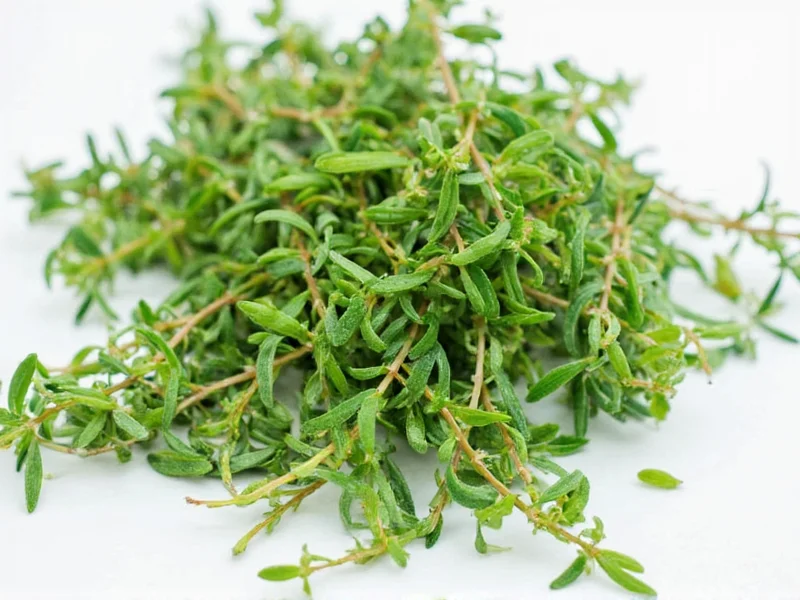When your recipe calls for thyme but your spice rack comes up short, knowing which herbs can effectively stand in becomes essential kitchen knowledge. Thyme's distinctive earthy, slightly minty flavor with subtle lemon undertones makes it a staple in Mediterranean and French cuisine. Whether you're mid-recipe or planning your herb garden, understanding thyme alternatives ensures your culinary creations maintain their intended flavor profile.
Top Herbs Similar to Thyme for Cooking
Thyme belongs to the Lamiaceae family, which includes many aromatic culinary herbs. The closest substitutes share chemical compounds like thymol that create that characteristic herbal depth. Let's explore the most effective thyme replacements and how to use them properly in your cooking.
Marjoram: The Closest Flavor Match
Often called "thyme's sweeter cousin," marjoram provides the most seamless substitution for thyme. While thyme has a more robust, slightly medicinal quality, marjoram offers a delicate floral note with less intensity. This makes it particularly valuable when substituting in lighter dishes like fish, vegetable preparations, or delicate sauces where overpowering flavors would be undesirable.
When considering herbs that taste like thyme for everyday cooking, marjoram works exceptionally well in tomato-based dishes, roasted vegetables, and poultry recipes. For the best results when using marjoram as a thyme replacement in recipes, remember that fresh marjoram has a more pronounced flavor difference from thyme than dried marjoram does.
Oregano: The Bold Alternative
Oregano shares thyme's earthy foundation but brings a more assertive, almost peppery quality to dishes. Mediterranean oregano (Origanum vulgare) works better as a thyme substitute than Mexican oregano, which has a completely different flavor profile. Oregano contains higher concentrations of carvacrol, giving it that distinctive pungency popular in Italian and Greek cooking.
When exploring best substitute for thyme in cooking for heartier dishes like stews, chili, or robust tomato sauces, oregano shines. Its stronger flavor means you'll typically need less—about three-quarters the amount of thyme called for in a recipe. This adjustment prevents your dish from becoming overly assertive while maintaining the herbal complexity thyme would provide.
Summer Savory: The Underrated Option
Less common in many home kitchens but highly valued by professional chefs, summer savory offers a peppery, thyme-like flavor with subtle marjoram notes. This annual herb provides a middle ground between thyme's earthiness and marjoram's sweetness. Winter savory has a stronger, more pine-like flavor that makes it less suitable as a direct substitute.
For those researching cooking with thyme alternatives for bean dishes, summer savory proves particularly valuable. Its flavor profile complements legumes beautifully, making it an excellent choice for substituting thyme in recipes like baked beans, lentil soups, or chickpea stews where thyme would normally feature prominently.
Comparing Thyme Substitutes: Flavor Profiles and Best Uses
| Herb | Flavor Profile | Best Substitution Ratio | Ideal Culinary Applications |
|---|---|---|---|
| Marjoram | Sweeter, floral, milder than thyme | 1:1 dried, 1.5:1 fresh to dried thyme | Fish, poultry, tomato sauces, vegetable dishes |
| Oregano | Bolder, more pungent, earthy | 3:4 ratio (use 25% less) | Pizza, pasta sauces, chili, robust meat dishes |
| Summer Savory | Peppery, thyme-like with marjoram notes | 1:1 dried, 1.5:1 fresh to dried thyme | Bean dishes, lentil soups, stuffing, grilled vegetables |
| Rosemary | Pine-like, stronger, more assertive | 1:2 ratio (use half the amount) | Lamb, roasted potatoes, focaccia, hearty stews |
| Basil | Sweet, anise-like, less earthy | 1:1 for fresh applications only | Tomato-based dishes, caprese salad, pesto, summer recipes |
Practical Substitution Guidelines
Understanding how to substitute oregano for thyme requires attention to both quantity and timing. Because dried herbs have concentrated flavors compared to fresh, always adjust your measurements accordingly. When replacing dried thyme with dried substitutes, maintain the 1:1 ratio for marjoram and savory, but reduce oregano by 25%. For fresh herb substitutions, you'll generally need 1.5 times more fresh herb to match dried thyme's intensity.
The timing of when you add your substitute herb also matters significantly. Thyme's flavor develops slowly during cooking, making it ideal for long-simmered dishes. Marjoram and oregano release their flavors more quickly, so add them later in the cooking process to preserve their delicate notes. For quick-cooking dishes like sautés or fresh salads, fresh substitutes work best, while dried versions excel in slow-cooked recipes.
Growing Thyme Alternatives
If you maintain a kitchen garden, knowing which herb similar to thyme grows best in your climate can ensure a steady supply. All these herbs thrive in well-drained soil with full sun, but they have different hardiness levels. Thyme and oregano are perennial in USDA zones 5-9, returning each year with minimal care. Marjoram and summer savory are typically grown as annuals in most climates, though they may survive mild winters.
When planting these herbs, remember that rosemary requires excellent drainage and can grow quite large, while oregano spreads aggressively and benefits from containment. For gardeners seeking the closest growing conditions to thyme, marjoram shares similar water and soil requirements, making companion planting straightforward.
Preserving Your Herb Substitutes
Drying and freezing techniques affect how well your thyme alternatives maintain their flavor. Air-drying works well for oregano and marjoram, preserving their essential oils effectively. Freezing fresh herbs in olive oil preserves their flavor better than drying for delicate herbs like marjoram. When substituting preserved herbs for fresh thyme, remember that frozen herbs maintain more flavor intensity than dried versions, requiring less adjustment in your substitution ratios.











 浙公网安备
33010002000092号
浙公网安备
33010002000092号 浙B2-20120091-4
浙B2-20120091-4